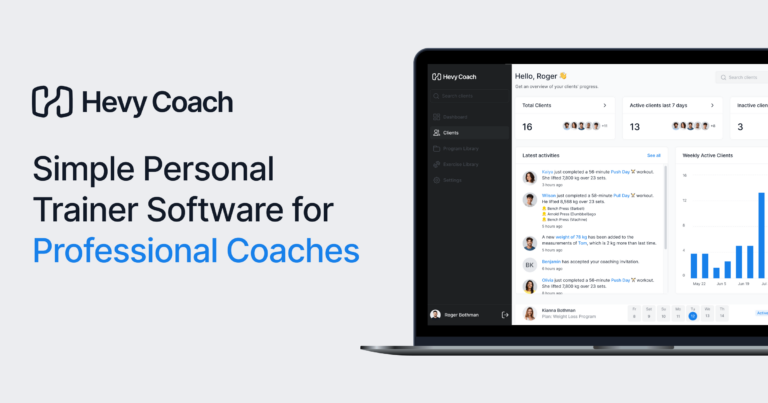Like it or not, fitness marketing is necessary to get yourself out there, build a brand people recognize, and grow a successful fitness business.
You can be among the best fitness professionals in the industry, but people won’t listen to you (or know you exist) if you don’t try to get yourself in front of them.
To that end, we’ve put together this guide to discuss the importance of fitness marketing, the essential rules you must follow, and the five effective strategies you can start using today.
Ready? Let’s discuss.
What are Effective Fitness Marketing Tactics?
Three of the most effective fitness marketing strategies are:
- Collaborate with influencers and indirectly leverage their following to grow your brand
- Experiment with paid ads on social media to target your ideal client
- Create an email list to collect the contact information of people interested in what you have to say and offer

Try Hevy Coach
Intuitive personal trainer software, with a world class experience for your clients.
30 day free trial, no credit card required
What is Fitness Marketing?
Fitness marketing focuses on promoting fitness businesses, their products, services, content, etc. Marketing strategies can include sharing content on social media platforms, running a blog or Youtube channel, collaborating with influencers, investing in paid ads, and relying on good old word-of-mouth advertising (more on that below).
Let’s consider two knowledgeable and experienced fitness professionals––Mike and Laura.
Laura understands how important fitness marketing is and does everything she can to get in front of her target audience: guest blogging, collaborating with influencers, producing quality content on her blog and Youtube channel, sharing helpful posts on social media, etc.
As a result of her efforts, her name shows up in more conversations, and she finds it easier to attract new clients, retain her existing ones, and grow her personal training practice.
In contrast, Mike neglects marketing. He struggles to connect with prospective clients and finds it much more difficult to retain his existing ones despite being as qualified and experienced as Laura.
Mike might have a website and social media accounts, but he rarely updates them, and the numbers (visitors, followers, likes on posts, etc.) stagnate.
4 Core Rules for a Successful Marketing Campaign
1. Target a Specific Person
Trying to help various types of people with their fitness goals might seem like a good idea. Why box yourself in when you can target millions of people?
The problem is that casting such a wide net, so to speak, makes it difficult to hone your marketing message and connect with people. At best, you can rely on promotional text everyone has seen a million times before. Phrases like:
- “I’m going to help you add muscle.”
- “Get ripped and rock an impressive six-pack.”
- “Cut through the noise and learn what it takes to get fit.”
You might be able to help people achieve these things, but you will struggle to grow your following and make a difference.
Knowing who you are trying to target is a good way to make any marketing strategy more effective. That means identifying a specific niche and your ideal client by asking relevant questions:
- What am I best at?
- Who can I help with their goals?
- What struggles does my ideal client have?
- What goals would that person want to reach?
That could mean helping busy professionals squeeze quick workouts into their days, mothers regain fitness after pregnancy, or older adults improve mobility.
2. Set Yourself Apart
Targeting a specific niche (e.g., busy dads) is a great first step to setting yourself apart, but it’s far from the only one. The fitness industry is saturated, which means you must find a way to cut through the noise and stand out.
You could be an excellent trainer with years of experience, but why should anyone choose to follow you on Instagram or hire you over the thousands of other coaches?
One way to set yourself apart is by offering a unique selling proposition (USP) that makes your products and services different and better. This could mean offering superior customer service (always replying within an hour), teaching people a new method you’ve developed, or providing a unique client experience.
Anything that could make your client’s life easier and fitness journey more enjoyable can be your USP. For example, if you decide to work with busy dads, your specialty could be crafting quick but effective resistance workouts that require adjustable dumbbells and resistance bands.
By setting yourself apart, you can attract people who seek precisely what you offer.
3. Display Social Proof
Social proof (client case studies, testimonials, positive reviews, etc.) is among the most powerful marketing tools. Unlike the promotional material you write to market yourself, social proof provides tangible evidence that you know your stuff and can help people reach their goals.
For example, sharing a case study of a client is an excellent way to market yourself, provide a glimpse into your coaching style, and show prospective clients precisely how you can help them.
You can talk about the training journey, nutritional recommendations you’ve given, and other details.
On top of that, ask your clients to write reviews or record testimonials for you to display alongside case studies, social media posts, etc. That way, you’re not just telling people what you’ve done to help clients; you allow clients to tell your audience why working with you is a good idea.
4. Tell People Exactly How You’re Going to Help
Telling people how you will help them ties directly to the first rule discussed above: finding your niche. Being clear on who you can help makes it easier to clarify your marketing message and boost its impact.
Consider the following example:
“I help guys build muscle.”
Sure, that is better than nothing, but it’s still not that specific and might not attract the attention of as many people.
Perhaps a better message would be:
“I help busy dads build muscle and lose fat with quick and challenging workouts consisting of bodyweight, band, and dumbbell exercises.”
On that note, you can further set yourself apart by sharing information on what tools you might use to help the client. For example, if you use a coaching platform like Hevy Coach, tell prospective clients:
“I will coach you through a simple online platform that allows me to deliver workout routines, make adjustments when necessary, and track your daily progress.”
A Deeper Look at 5 Effective Fitness Marketing Strategies to Leverage in 2023
1. Collaborate with Influencers
Collaborating with influencers is an effective social media marketing strategy because it lets you indirectly leverage their following to benefit your brand.

By showing up in front of their audience, you get your name out there and can enjoy a significant following boost, so long as people like what you offer.
These collaborations can take different forms, depending on your target audience, unique strengths, and business goals. For example:
- You possess a special skill you can display in front of an influencer’s audience
- You’re a fantastic cook and want to share a great recipe and demonstrate how it’s done
- You’re an expert on a specific topic and can write an article or record a video for their Youtube channel or blog (there is also potential for repurposing some of that content for social media posts, further getting your name in front of that influencer’s audience)
It could also be as simple as getting together to do a challenge (e.g., who can do 50 or 100 pull-ups quicker) or workout. Challenges offer some unique opportunities to show originality, whereas collab workouts are more along the lines of tried and true.
For example, people working at wellness centers, where the focus is to help clients improve their health through a holistic approach, could collaborate with well-known fitness experts to offer a breath of fresh air.
Instead of discussing the same things as everyone (lift heavy, eat enough protein, sleep well, etc.), such experts can share unique tactics people might not have heard before.
The beauty of collaborations is their win-win nature. When done right, you can enjoy growth in your business while that influencer gets to post fresh and original content to maintain engagement on their social media profiles, Youtube channel, and website.
Aside from these direct collaborations, you can reach out to influencers and ask them to review a product or service you offer. These are typically paid; the fee depends on their follower count and engagement.
Check out our article on becoming a fitness influencer for more insight.
2. Advertise on Social Media
Paid advertising can be a hit-or-miss marketing strategy, especially for inexperienced people, but they are an avenue worth exploring. Platforms like Instagram, TikTok, Facebook, and Twitter can help you reach your target audience and attract potential clients.
The problem is that it takes time and money to experiment with ads and figure out how everything works––crafting the perfect ad, targeting the right people, calculating your ROI (return on investment), and more.
Let’s start with the first essential step: crafting your ad. As discussed previously, successful marketing campaigns require a few things, including knowing who you want to target and telling people how you’re going to help them.
Doing so allows you to clear up your marketing message and write ads that catch people’s attention. First, you need a title to grab people’s attention. It needs to be short, clear, and informative.
Second, you need to write an engaging copy (the central promotional part of the ad) and clearly outline what benefits people will experience if they hire you or purchase your product.
Aside from these, you need an image or video content to make your ad pop out when people scroll on social media. Text alone won’t cut it. Hiring a designer or editor to help with that part of the ad might be best.
Next up, we have targeting options. Fortunately, most platforms make it easy to target the right people and boost the click-through rate (the percentage of people who click on the ad to learn more instead of just scrolling past it).
You can even use lookalike audience tools to find people similar to your audience––demographics, interests, liked pages/followed people, etc.
Another critical area is calculating the ROI––in other words, are you earning more from your ads than you are spending? For instance, if you invest $1000 in ads and sign five clients, each paying $300, earn $500 over your initial investment, making your ad campaign successful.
Related article: How to Advertise Myself as a Personal Trainer? (4 Key Areas to Focus On)

Try Hevy Coach
Intuitive personal trainer software, with a world class experience for your clients.
30 day free trial, no credit card required
3. Create Content Online to Grow Your Following
Content marketing is another powerful way to grow your business, but it requires the right tactics and patience. The advantage is that you can use several channels and try various content formats––social media posts, blog articles, Youtube videos, video shorts, email newsletters, podcasts, etc.
First, consider creating a website to use as your central ‘hub’ for online content. Even if you primarily publish content elsewhere, you can use your website to link to each piece of content you produce and drive traffic through Google using search engine optimization (SEO). There are plenty of SEO tools online, but we reccommend an affordable SEO tool like Clicks.so to help you with keyword research, competitor analysis, and site audits.
Your website can also be the perfect place where prospective clients learn more about you and what you offer. Have the following pages:
- About – share your story and bio
- Landing page – outline your products and services
- Contact – clearly explain how and where people can reach out
As for the content format, pick something that works for you. Are you great in front of a camera? Consider starting a Youtube channel and recording long or short videos on various interesting topics.
Prefer the written word? Write articles, short blogs, and social media content to educate and inspire people.
Content creation opportunities are numerous. Success relies on consistency, authenticity, uniqueness, and, most importantly, being helpful. When producing content, ask yourself, “Does my audience get anything out of this piece of content? Do they learn something they can apply right away?”
If the answer is yes and your content is genuinely engaging, you will build an audience.
Related article: 16 Fitness Content Ideas to Grow Your Business
4. Create an Email List
An email list is a collection of email addresses you gather, typically by offering people something free: an eBook, email course, discount code, content upgrade (content directly tied to an article or video you’ve produced), etc.
For example, someone visits your website to read an article on optimal training for muscle growth. The freebie could be a quick nutritional guide for muscle gain that serves as a content upgrade.
The person shares their email and receives the guide in PDF form on their email address.
One advantage of building an email list is that you collect the contact information of people who explicitly show interest in what you can offer. These aren’t cold leads but people who have entered their email addresses to get something from you.
As such, these people are far more likely to engage with your brand in the future, so long as you make an effort to engage with them. For example, you can create a weekly email newsletter where you discuss various topics, give updates about the brand, ask questions to subscribers, etc.
When it’s time to sell something, be it your services or a product, you can reach out to your email list or create a series to increase the conversion rate.
Sign up for a tool like ActiveCampaign, Aweber, or MailChimp to start your email list. These services store all the information, allow you to segment your list (e.g., based on interest), and more. You can send a single email to hundreds or thousands of people with a single click.

Add a sign-up form (a small box where people can share their email addresses and subscribe) to your website. You can also create a dedicated landing page to encourage email sign-ups and link to it from your social media and Youtube channel.
5. Leverage Word-of-Mouth Marketing
Word-of-mouth marketing (WoMM) is one of the most effective fitness marketing strategies to grow your business and influence. The best part? It doesn’t cost a dime.
The premise is simple:
Provide an excellent service or sell a high-quality product that leads to a positive experience with your brand, prompting the person to promote you to their friends and family.
Let’s say you’re a weight loss coach, and someone hires you because they want to lose 30 to 35 lbs. You help them reach that goal by offering superior guidance and accountability. Along the way, you show empathy and patience, helping the person navigate the daily challenges without criticizing their shortcomings.
You help that person reach the goal and teach them how weight loss works and why you get them to do specific things, making them more independent. As a result, that client is thrilled with your service and is more than happy to promote you to friends and family who also want to lose weight.
Of course, while WoMM is a simple concept, it isn’t easy to apply because it requires the proper knowledge, expertise in your area of work, and the willingness to go above and beyond for your clients.
The power of WoMM as a fitness marketing strategy is that someone else gives you praise and discusses your brand with people they know. This makes you far more desirable than if you were to talk about the greatness of your services.
Final Words
Digital marketing is necessary for growing a successful fitness business. Even the biggest brands, like Apple, market their products and generate engagement for months before big launches because they understand how powerful marketing efforts can be.
Whether you choose an article, email, video marketing, or some other way to promote yourself, you must make an effort to get yourself in front of the right people. There are plenty of fitness marketing ideas to experiment with and combine to see what yields the best results.
Plus, if the whole fitness marketing thing feels too overwhelming and you’re unsure where to start, you can always hire a fitness marketing agency or work with an expert to get an idea of what to do.
But, regardless of where you stand now, there is no reason not to try some marketing strategies, even if you can’t invest money immediately. There are free options you can leverage to grow your influence––content and email marketing, social media, etc.
Check out Hevy Coach before you go. Our all-in-one platform is designed for personal trainers and coaches, allowing them to easily create routines for clients, make adjustments when necessary, track their progress, and much more.
FAQs
1. What is fitness marketing?
Fitness marketing focuses on promoting people, products, and services in the fitness industry to grow brands and attract clients.
2. How can social media be used effectively for fitness marketing?
Share helpful and engaging content and invest in paid ads to grow your following and attract your ideal client.
3. What content should fitness professionals offer for free to attract clients?
Articles, videos, social media posts, eBooks, email courses, free workouts, nutritional guidance, and content upgrades (specifically tied to a piece of content) are some of the best pieces of content you can create to grow your audience and attract clients.




